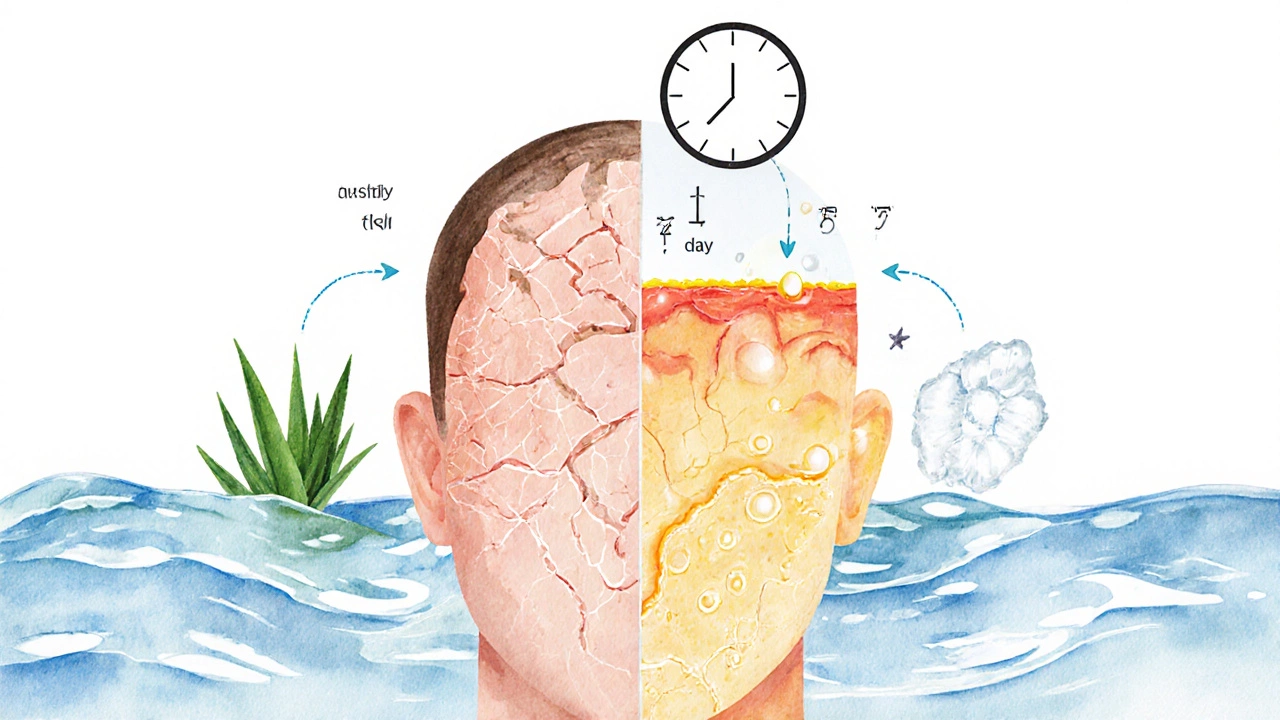Washing your hair every day feels like a habit, but it might be hurting more than helping. If your hair gets oily by noon, or you’re constantly reaching for dry shampoo, you’re not alone. But here’s the truth: there’s no universal rule for how often you should wash your hair. It depends on your scalp, your hair type, your lifestyle, and even the climate you live in. In Wellington, where damp winds and salty sea air are part of daily life, people often get this wrong-washing too much or too little-and end up with either greasy roots or brittle, frizzy ends.
Your scalp decides the schedule, not the calendar
Your scalp produces sebum, a natural oil that keeps your hair moisturized and protected. Too little, and your hair gets dry and brittle. Too much, and it looks greasy and flat. The goal isn’t to remove all oil-it’s to balance it. Most people don’t need to wash daily. In fact, washing every day can strip your scalp of its natural oils, causing it to overproduce sebum to compensate. That’s why your hair feels greasy again within hours after washing-it’s a cycle you’re trapped in.
Think of your scalp like your skin. You wouldn’t wash your face with hot water and harsh soap five times a day, would you? Your scalp deserves the same respect. Start by tracking your hair’s behavior. Do you feel oily by day two? Then you might be in the 2-3 times a week range. Does your hair look clean and bouncy on day four or five? You might only need to wash once or twice a week. Give yourself at least two weeks to adjust before deciding.
Hair type matters more than you think
Not all hair is the same. The texture, curl pattern, and thickness change how oil travels down the strand-and how often you need to wash.
- Straight or fine hair: Oil travels quickly from scalp to ends. You might need to wash every other day or every two days. If your hair looks limp by day three, you’re not doing anything wrong-you just have a high-sebum system.
- Wavy or curly hair: Curl patterns slow down oil movement. Washing every 3-7 days is usually enough. Many people with curls go even longer without washing and use co-washing (conditioner-only washes) in between to refresh.
- Thick or coily hair: This hair type holds moisture well and rarely gets greasy fast. Washing once a week or even every 10-14 days works for many. Overwashing can lead to dryness, breakage, and frizz.
There’s a reason why people with natural curls often skip shampoo for weeks. Their hair doesn’t need it. What it needs is moisture and gentle cleansing. If you have curls and you’re washing daily, you’re likely stripping away the very oils your hair needs to stay soft and defined.
Scalp conditions change everything
If your scalp is flaky, itchy, or red, washing frequency isn’t just about oil-it’s about health. Dandruff, seborrheic dermatitis, or psoriasis can make your scalp overproduce skin cells or become inflamed. In these cases, you might need to wash more often, but with the right products.
For dandruff, dermatologists often recommend medicated shampoos with zinc pyrithione, ketoconazole, or salicylic acid. Use these 2-3 times a week, even if your hair isn’t oily. Let the active ingredients sit on your scalp for 5 minutes before rinsing. After a few weeks, you can often reduce frequency as the condition improves.
On the flip side, if your scalp feels tight, itchy, or burns after washing, you’re probably using harsh sulfates or washing too often. Switch to a sulfate-free, fragrance-free shampoo and extend the time between washes. Your scalp will thank you.

Lifestyle and environment play a big role
Living in Wellington means you’re exposed to wind, rain, salt air, and pollution-all of which can build up on your hair. If you bike to work, sweat during workouts, or use a lot of styling products, you’ll need to wash more than someone who stays indoors all day.
Here’s a simple rule: if you’ve sweated heavily, washed your hair after exercise. Sweat contains salt and urea, which can irritate the scalp and clog follicles over time. But you don’t need a full shampoo every time. A quick rinse with water, or a gentle clarifying wash once a week, is often enough. On non-sweat days, just rinse with water and condition the ends if needed.
Heat styling, color treatments, and chemical relaxers also stress your hair. If you color your hair, washing less often helps preserve pigment. Use cool water when rinsing, and consider a color-safe, sulfate-free shampoo. Washing every 3-4 days is ideal for maintaining vibrancy without drying out your strands.
Signs you’re washing too much-or too little
It’s easy to misread what your hair is telling you. Here’s how to tell if you’re off track:
- Washing too much: Hair feels dry, brittle, or straw-like. Scalp is flaky or irritated. Color fades fast. Hair breaks easily when brushing.
- Washing too little: Scalp is itchy or oily. Hair looks greasy by day two. Product buildup makes hair feel heavy or dull. You notice more shedding than usual.
If you’re seeing signs of damage, it’s not about washing more-it’s about changing your routine. Switch to gentler products, reduce frequency, and let your scalp reset. It can take 2-4 weeks for your scalp to rebalance after switching from daily washing to less frequent washing.
How to wash correctly
Washing less doesn’t mean washing poorly. How you wash matters just as much as how often.
- Wet your hair thoroughly with lukewarm water. Hot water strips natural oils and dries out your scalp.
- Use a quarter-sized amount of shampoo. Focus on your scalp, not the ends. Massage gently with your fingertips-don’t scratch with your nails.
- Rinse well. Leftover shampoo causes buildup and irritation.
- Apply conditioner only to the mid-lengths and ends. Avoid the scalp unless it’s extremely dry.
- Let your hair air-dry when you can. Heat tools damage hair over time.
Consider co-washing (conditioner-only washes) every other wash if you have curly or dry hair. It removes light buildup without stripping moisture. Look for co-washes labeled “sulfate-free” and “hydrating.”

What to avoid
There are myths that keep people stuck in bad routines:
- Myth: You need to shampoo twice to get clean. Truth: One thorough wash is enough. The second lather doesn’t clean better-it just dries you out.
- Myth: Dry shampoo is a replacement for washing. Truth: It absorbs oil temporarily but doesn’t cleanse. Buildup from dry shampoo can clog follicles. Use it only between washes, not as a weekly substitute.
- Myth: Natural oils (like coconut or argan) fix greasy hair. Truth: Applying oil to a greasy scalp makes it worse. Use oils only on dry ends, never on the roots.
Adjusting your routine: A 30-day plan
If you’re unsure where to start, try this:
- Week 1: Wash every other day. Use a gentle, sulfate-free shampoo.
- Week 2: Wash every 3 days. Rinse with water on off days if needed.
- Week 3: Try washing twice a week. Use a clarifying shampoo once to remove buildup.
- Week 4: Observe. Does your hair look healthier? Is it less oily? More manageable?
By the end, you’ll know your sweet spot. Some people find they’re happiest washing once a week. Others need three times. Both are normal. There’s no right number-only what works for your body.
When to see a professional
If after adjusting your routine for 6 weeks, your scalp is still itchy, flaky, or inflamed-or your hair is thinning, breaking, or falling out in clumps-it’s time to see a trichologist or dermatologist. These aren’t just "hair issues." They can be signs of hormonal imbalances, nutritional deficiencies, or underlying skin conditions.
Don’t wait until your hair is falling out. A simple scalp check can reveal what’s really going on. You don’t need expensive treatments-often, just the right shampoo and adjusted washing habits make all the difference.
Your hair doesn’t need daily cleansing. It needs balance. Give it time. Listen to it. And stop letting marketing tell you how often to wash. Your scalp knows better.
Is it bad to wash my hair every day?
Washing every day isn’t inherently bad, but it’s often unnecessary and can dry out your scalp. Daily washing strips natural oils, which can trigger your scalp to produce even more oil, creating a cycle of greasiness. If you sweat a lot, exercise daily, or have very fine hair, daily washing might work for you-but most people do better with 2-4 washes per week.
Can I wash my hair with just water?
Yes, you can rinse your hair with water alone, especially on non-shampoo days. Water removes sweat and light dust but won’t remove oil, product buildup, or sebum. It’s a good option for people with curly, coily, or dry hair who want to reduce shampoo use. For deeper cleaning, use a gentle shampoo once or twice a week.
Why does my hair get oily so fast?
Fast oiliness is usually caused by overwashing, which signals your scalp to produce more sebum. It can also happen with fine hair, hormonal changes, or using heavy products. Try switching to a mild shampoo, washing less often, and avoiding oil-based styling products on your scalp. Give it 3-4 weeks to reset.
How do I know if I have product buildup?
Signs include dull, heavy hair that doesn’t hold styles, a greasy scalp even after washing, or conditioner that doesn’t seem to rinse out. If you use a lot of sprays, serums, or leave-ins, try a clarifying shampoo once a month. It removes residue without stripping your hair.
Should I wash my hair before or after working out?
If you sweat heavily, rinse your hair with water after your workout to remove salt and sweat. You don’t always need shampoo. If your hair feels sticky or smells sour, then shampoo. For light workouts, a quick rinse is enough. Overwashing after every gym session can dry out your scalp.
Does cold water make my hair shinier?
Yes, rinsing with cool water at the end of your wash helps seal the hair cuticle, making hair look smoother and shinier. It also reduces frizz and helps lock in moisture. You don’t need to ice-bathe your hair-just finish with a 30-second cool rinse.

